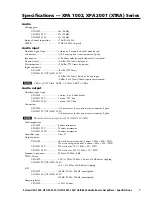
The Amp ID’s
The Amp ID’s given to each amplifier in a NexSys system are composed of two
independently adjustable two-digit hexadecimal values. It is not necessary to fully
understand hexadecimal numbering in order to set an Amp ID, but it is helpful to
know. Also, when the numeric display reads “AE,” the operator will realize this is a
completely normal number when working in hex, and there is no cause for alarm!
Hexadecimal or “hex” numbering is a system of counting widely used in digital
technology and in the design of digital systems. This is largely because of its close
relationship to binary numbering, which is the counting scheme that makes up the
fundamentals of all digital technology. Hexadecimal is a Base-16 numbering system, as
opposed to binary, which is Base-2, or our comfortable, everyday decimal numbering
system, which is Base-10.
The “base” of a numbering system is simply the number of digits in the system. For
example, the garden-variety decimal system has ten digits (“0,” “1,” “2,” “3,” “4,” “5,”
“6,” “7,” “8,” and “9”) and therefore we say it is a Base-10 system. Binary, as the name
implies, has only two digits – the lowly “1” and the humble “0.” However, these two
digits can still be used to represent infinitely large numbers just as effectively as the
decimal system. In fact, while most humans think in terms of the decimal system,
computers and digital devices “think” in terms of the binary system.
Hex uses sixteen digits – all of the numerals used in the decimal system, plus the first
six letters of the alphabet. Therefore, counting from zero in hex one has “0,” “1,” “2,”
“3,” “4,” “5,” “6,” “7,” “8,” “9,” “A,” “B,” “C,” “D,” “E,” and “F.” Remember, the digits are just
symbols representing a value – they could be numerals, letters, hieroglyphs, dots of
different colors, anything. This is important to keep in mind, because many systems
(including the three mentioned here) just so happen to use many of the same symbols,
however in the different systems they may not always represent the same value. This is
where confusion often arises, and it is an issue that will be address shortly.
Counting in the decimal system, once “9” is reached there are no more different
symbols to use. The solution is to start combining digits in a logical fashion, by adding
a new placeholder. The result is the number “10.” The value in this new place is worth
ten times the placeholder to its right, and as we all know we can continue this pattern
indefinitely. However, the reason each value is worth ten times the placeholder to its
right is because decimal is a Base-10 numbering system. This is not a hard and fast
rule, although it may seem to be because the Base-10 (decimal) system is used almost
exclusively in day-to-day life. However, in Base-2 for example, each placeholder is
worth two times the placeholder to its right, and in Base-16, sixteen times.
Here is the decimal example described:
10 = (1*ten) + (0*one) = ten
Likewise, other decimal values:
35
= (3*10) + (5*1)
= 30 + 5
= 35
528
= (5*100) + (2*10) + (8*1)
= 500 + 20 + 8
C
Kd
owner’s manual
NexSys
®
Modules
CKd Series Owners Manual v1e
Page
20
Summary of Contents for CKd Series
Page 1: ...608 608 ...
Page 27: ......









































